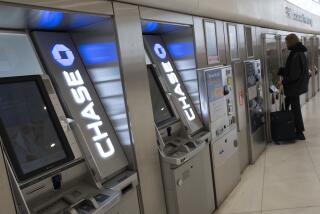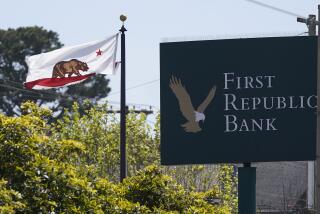U.S. Seeks Bank Levy to Aid FDIC : Finance: Industry will be asked for $25 billion to shore up insurance system. Firms in return should be allowed to enter other businesses, Seidman says.
- Share via
WASHINGTON — The Bush Administration and federal regulators will ask the banking industry--rather than U.S. taxpayers--for an extra $25 billion to replenish the rapidly dwindling insurance fund that protects depositors in case of bank failures, a top federal regulator said Monday.
Regulators are discussing with bankers the details of a major financial contribution by the industry, an amount equal to approximately 1% of all deposits, L. William Seidman, chairman of the Federal Deposit Insurance Corp., told a congressional hearing.
The one-time levy would represent a vast increase in payments by banks, which already are scheduled to pay insurance premiums of approximately $6 billion a year over the next three years. The special levy would substantially exceed the current yearly profits of the industry.
But Seidman said the levy is essential to save the fund, adding: “The resort to the taxpayer is the last resort. It ought not to be done while the industry can handle the problem.”
In return for providing badly needed cash for the insurance fund, banks should be granted broad new powers to move into other lines of business, and the traditional state barriers limiting bank expansion should be abolished, Seidman told the financial institutions subcommittee of the House Banking Committee. The expansion of bank powers will be the centerpiece of the Bush Administration’s financial reform program next year.
Seidman called on Congress to take action early next year on the reform package, including the special levy to bolster the fund that protects deposits up to $100,000.
Bankers say they are willing to pour additional money into the insurance fund as part of a legislative package enabling them to enter the insurance and securities businesses without restraints.
“We have always paid whatever was necessary to keep the fund on a sound footing, and we have the willingness to continue doing so,” said Mark Burneko, a spokesman for the American Bankers Assn. “The bottom line is the need to get the fund up as quickly as possible without imposing an overwhelming financial hardship on the industry.”
The insurance fund, which held $18.3 billion just four years ago, will finish this year at $9 billion and plunge to $4 billion by the close of 1991, Seidman said. The fund has declined as more than 800 banks have failed since 1986. Approximately 180 more are expected to fail next year.
Currently, banks pay 19.5 cents into the insurance fund for every $100 worth of deposits. Those premiums, interests on investments and the special 1% levy on all deposits could generate $52 billion over the next three years to pay for losses involved in shutting down insolvent banks and paying off insured deposits. Almost half the money, about $25 billion, would be generated by the one-time 1% levy on deposits.
Outlays by the insurance fund depend on the size of losses at individual banks, with the insurance money filling in the gap between the bank’s deposits and the weakened value of its real estate loans and other assets.
A $52-billion cushion could enable the fund to handle bank failures involving total assets of $270 billion to $320 billion, Seidman noted. With that cushion, the FDIC “fund should be able to handle the problems of the next three years unless a disaster occurs,” he said.
A special assessment of $25 billion would represent about two years’ worth of bank industry profits, according to a projection by R. Dan Brumbaugh Jr., an economist who testified before the committee.
“The ability of the banks to take that additional money out of earnings depends on what happens in the economy,” said Burneko of the ABA. “There is still considerable uncertainty. The scenarios on losses are quite widespread.”
One possible way to ease the financial burden on banks would be to permit them to spread the contribution over several years, according to government and industry sources.
The banks’ additional contribution would be included in the Bush Administration’s plan for the most sweeping overhaul of the financial system since the Great Depression. The proposal will be offered to Congress early next year.
If banks are allowed to enter nontraditional businesses as part of this overhaul, Seidman and other regulators want so-called “fire walls” built between divisions so insured deposits are not placed into risky ventures.
Regulators and bankers alike are quick to assert that the problems of banks are manageable.
The nation’s 12,400 banks had profits of $15.4 billion for the first three quarters of the year--a 13% improvement over the prior year.
Rep. Frank Annunzio (D-Ill.), the subcommittee chairman, said: “We need to make certain that the taxpayers of this nation, who already have been forced to pay too much for the savings and loan bailout, are not asked to bail out the banks or the bank insurance fund.”
Several panel members suggested that regulators should stop banks from paying dividends to stockholders until the crisis passes.
Administration officials and members of Congress believe the banking industry, although threatened by falling real estate values that have turned many loans sour, can avoid the crisis that gripped the savings and loan business. Financial and regulatory standards have been more strict for banks, and federal oversight has been more intense.
The collapse of hundreds of S&Ls; bankrupted the insurance fund protecting their deposits. It will cost taxpayers as much as $130 billion, without counting future interest on bonds, to finance the S&L; cleanup by closing crippled institutions and paying off insured depositors.
But if Seidman is correct, and the economic situation doesn’t worsen, the extra assessment on banks should keep the insurance fund for banks solvent.
The costs of bank failures over the next three years could range from $17 billion to $63 billion, depending on the severity and duration of the recession, according to a report presented to the subcommittee Monday by Brumbaugh and two other economists, Robert Litan and James R. Barth.
Forecasting can “only be educated guesses,” said Seidman, offering a skeptical view of the report. “Three years ago, who would have predicted that Germany would be reunited and that we would be shipping food to Russia? In three years, will we be in a booming economy, stagflation or a deep recession?”
His own educated guess is that a $25-billion infusion would keep the “weak” insurance fund working.
More to Read
Inside the business of entertainment
The Wide Shot brings you news, analysis and insights on everything from streaming wars to production — and what it all means for the future.
You may occasionally receive promotional content from the Los Angeles Times.










